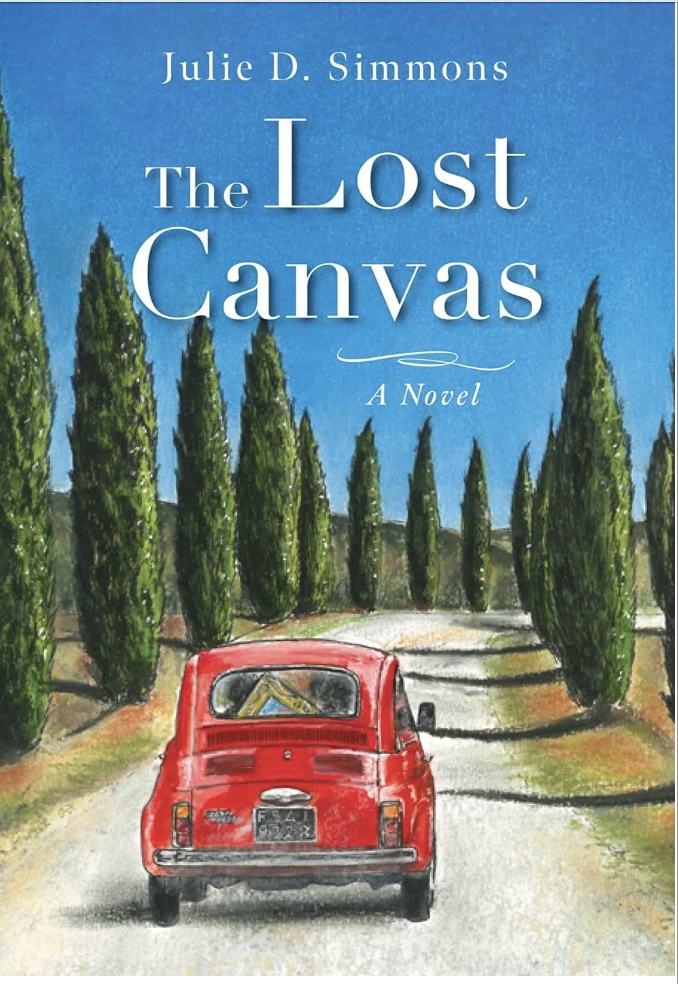
The Lost Canvas
Prologue
Millions of years ago, in the middle of the Mediterranean and
deep within the earth’s crust, tectonic plates collided. Like a
swimmer progressing into ocean waves, the African plate dove far
beneath its Eurasian cousin. Ancient sea floors were forced upward,
and in separate processes, first formed the Alps, the Dolomites, and
the Apennines, a spiny chain running south on a peninsula. The
ground buckled, and rocks piled high. Deep below, temperatures
rose, and pressures built, turning limestone to marble. Combining
forces created an endless cache of supplies, a geological canvas abiding
for engineers, artisans, and builders who would come to be in the
Birthplace of the Renaissance.
Millennia passed, rains fell, and the winds danced among the
mountain peaks and the Adriatic Sea. Erosion moved sediment between
the two, forming protected valleys with gentle slopes. A harmonious
balance of geology, sunshine, and weather—a combination
conducive for making grapes in a most excellent terroir but also
superb for figs, olives, and dates. People inhabited the land, raising
animals and cultivating plants, creating picturesque landscapes with
rows, orchards, vineyards, gardens, and farms that exemplified the
most beautiful and astute husbandry practices on the earth.
With generations of effort, from Rome and Florence and out
into the countryside, customs accumulated, and like the raising of
healthy children, understanding and wisdom grew. Learned techniques
became repetitive, and the people passed down their stories
and skills, establishing continuity meant for preservation. From the
Ancient to the Renaissance to the Baroque and then the Romantic,
creativity evolved and flourished.
The beauty and wonder of the art, architecture, science, and ways
of law established by the Italians, a source of utmost pride, gave good
reason to hold on to traditions and craftsmanship still revered across
the world today. To maintain a certain way of life and family solidarity,
villas and farmhouses were all built to endure, ensuring a legacy
created by their own hands. And from the art of spoken and written
words sprang many a good story, such as the one that follows.
Chapter 1
Katie Bauer took the front steps out of the historic hotel and,
like most days, jaywalked across the street to Travis Park. The
green space, an oasis in downtown San Antonio, drew local lunch
crowds, students, and even occasional tourists. With sweltering Texas
temperatures fading, the day bright as the calendar months reached
toward another year, live oaks stretched across old grounds of the
Alamo mission. Situated on a wooden bench, Katie took an apple
from her big tote and searched for other options. Should I eat the peanut
butter crackers or the apple first? As she pondered that, her phone
buzzed. Digging around in the bag again, she located it, glancing at
the caller ID before answering.
“Mr. Pickett. I was just wondering about you.” Before he answered,
Katie collected her things, and rose from the bench, tossing
the half-eaten fruit into a nearby trash bin.
Forgoing small talk, Mr. Pickett went straight to business. “I have
something for you.”
“I’m on my way.” Katie exited the park and, glancing up at the St.
Anthony, shielded her eyes from the sun. This side of the art nouveau
hotel was partially shaded, steel floor-to-ceiling arched windows set into
its north wall. Graceful and sinuous, like turn-of-the-century French
models, they provided a clear view into the interior of the Peacock Alley
lounge. Transparent windowpanes revealed gold and green carpets,
velvet furnishings, period chandeliers, and sconces, their fixtures fusing
structure with ornament. She focused, however, on the white plastered
walls, the space and columns in between, that belonged to her.
As curator for the historic hotel, Katie filled the spaces in the
lobby, lounge, and hallways with art. Her roles included marketer, art
historian, buyer, researcher, event planner, exhibit designer, and facilitator
for interactions between guests, art, and artists. In five years
of employment, she had proved her talent at selecting and acquiring
works that transformed the common areas into a true gallery, both
for long-term and temporary exhibits.
In a space like the St. Anthony, interruptions by doors, windows,
and other features presented compositional challenges, but Katie
liked irregular dimensions. Putting all the pieces together, researching,
acquiring, framing, and placing art, she sculpted the brand of the
hotel and sold paintings.
Taking a left on Travis Street, she hurried down the block. Going
right at the light to cross onto Jefferson, Katie maneuvered through
the city with ease. She passed other historic hotels and churches built
just after the Texas Revolution and skipped down a flight of stone
steps onto the riverwalk to avoid street traffic. The Paseo Del Rio,
a fifteen-mile-long network of landscaped walkways and bridges,
framed the banks of the San Antonio River.
A gift of life certainly derived from a generous deity; the river
originated from a great underground aquifer. Central to the city’s
deep cultural origins, indigenous people had thrived along the waterway
for thousands of years.
After the Age of Discovery, with water more valuable than gold,
explorers established a series of missions, expanding Spanish New
World influence. Franciscan priests, backed by the Catholic Church
and royal financing and accompanied by master carpenters, masons,
and blacksmiths, taught the trades to Pueblo Indians, building five
missions along the river, all a few miles apart. Each included a chapel,
protective walls, and indoor living quarters.
Native Americans in the area, made weary by vicious Apache
and Comanche attacks from the north and weakened by European
diseases, traded their idols for saints, accommodating more Spanish
conversions to further the colonization of the local peoples. In a symbiotic
relationship, the Crown expanded Spanish civilization while
the natives welcomed the benefits of shelter and food in exchange for
defending the northern frontier for the Spanish empire. Excepting a
historical blink with the French, the Spanish flag flew across the land
for over three centuries until Mexico took over for more than a decade.
Latin influence made permanent marks that abounded throughout
the river city, with red clay rooftops, stucco facades, and archways
decorated with intricate painted tiles. Mariachi bands added to
the ambience, making local cuisine taste even better. Situated below
street level, the pathway provided locals and visitors a scenic route for
navigating the city.
At the bottom of the steps, Katie slowed while people, umbrellaed
by giant cypresses, ambled along the winding stone walks to consider
restaurants or shopping. The water was cool and green, dotted with
occasional groups of ducks. They swam across the surface, making upside-
down V patterns in their gentle wakes. Paddlings, Katie thought.
This was a trivia game she liked to play in her head. The correct
terms for groups of animals. A group of birds could be called a flock, but
paddlings are more specific and correct to ducks. Pigeons, scavenging for
crumbs beneath café tables, fluttered near her feet. A band of pigeons.
Some of the birds here on the riverwalk, ducks in particular,
were celebritized local characters with proper names. Tourists often
stopped to get photos while children threw small pieces of bread
into the water. Katie paused next to two little boys and pointed out
into the river. “Look. See the duck with the funny neck? Her name
is Georgine.”
“That one right there?” The smaller child pointed. Georgine
dove under, headfirst, orange feet flapping at the surface.
“Yes! That’s her!”
The boy’s parents smiled at Katie. “Thank you! Say thank you to
the nice lady,” they said.
Walking away, Katie waved.
San Antonio was a big, small town. Friendly Texans here, in all
shapes, sizes, and colors, was an actual thing. This was Katie’s town, for
which she possessed a fierce and loyal pride. It mattered to her that visitors
went home with good things to say about the city and the locals.
Popping back up on Presa Street, she arrived at La Villita, a
shopping village just beyond the riverbank with a three-hundred-year
history, a cornerstone to the city’s foundation. The “little village”
was a cultural hub and home to shops of local artisans and craftsmen.
Katie ducked into her favorite gallery. An old-fashioned bell on the
big wooden door announced her arrival.
“Mr. Pickett?” As she entered the estate gallery, a sense of reverence
enveloped her. As if she were stepping into a cathedral, she spoke
a little quieter and walked a little softer. On paneled walls were private,
collective sums from the past. Lifetime collections, some eclectic
and others homogenous, defined years, interests, and meticulous considerations
by their owners. These assemblages, biographies of souls,
represented histories of personal evolution. She studied a small oil
of sailboats anchored in a bay. Most likely the Mediterranean. She
picked it up and turned it over. Nonmitered stretcher bars on the back
of the canvas told her the painting was European. Looking closer,
she noticed a faded address, Sorrento, Italy. Maybe the owner’s residence
or a frame shop? Or that of a gallery? The hardware was somewhat
grimy, and the gilded frame was hand carved. She turned it back
around to study the front. The signature must be on here somewhere.
"Katie.” Mr. Pickett approached the girl, then, “Katie!”
“Oh!” She took a moment and a deep breath. “You startled me.”
“I’m sorry.” He placed a hand on her shoulder. “Nice, isn’t it?
When?”
Nodding, she replaced the little seascape where she had found it.
“Turn of the century, a little before.”
“That’s my girl,” he said, giving her a slight squeeze. Tall and
lanky, Mr. Pickett’s hand wrapped fully around the front and back of
her shoulder. Huge, generous, and kind, they had loved a wife for half
a century, a family, and grandchildren. His wife gone, his children
grown professionals in other places, his affection was mostly reserved
for Kaiser. These days, Kaiser came to the gallery with Mr. Pickett.
Each morning, the two shared a concha, a sweet Mexican bread with
white icing, and a short commute from the bedroom neighborhood
where they lived off Broadway into downtown. Kaiser at his side, Mr.
Pickett rubbed the black Doberman’s ears. Stoic and silent, the big
dog leaned into him. “Wait until you see what I have for you, Katie.”
“You have my attention.” She followed him behind the counter
and into the back of the gallery.
Supporting each other on the far wall of his office, new stacks
of paintings waited, most still wrapped in layers of brown paper. Mr.
Pickett took a large piece from the front of the assortment. Slow and
steady, he removed the painting from its encasement and set it upright
on a large table, giving Katie eye-level perspective.
“This one isn’t part of that estate.” Mr. Pickett gestured toward the
paintings. “It came in by itself. A man from New Braunfels brought it
in. Said it belonged to an aunt, and she had hung it in her house as for
long as he could remember. No idea where she acquired it.”
Katie absorbed the painting with sunset tones in the distance
and earth tones, silver to sage, in the foreground. Mr. Pickett stood
back, arms folded across his chest and waited. An apparent signature,
in darker paint—she didn’t recognize the artist. Spontaneous
brushstrokes flowed across the canvas. Their dark vertical emphatic
marks created textures, and at the top were blue and gold pigments
blending. A fiery half orb in the background drew the eyes
to a horizon, and cool colors rendered faraway hills, with twinkles
in the sky, some of them falling toward the ground. It reminded her
of something smooth by Santo and Johnny. Making her heart beat
one tick faster, the internal music grew louder and more distinct.
Starting at the corners of her eyes, Katie’s entire face broke into a
smile.
“Just what I thought,” Mr. Pickett said.
“Can we?” Katie asked, gesturing toward the back.
“It’s all yours. I haven’t touched it.”
Katie squeezed her hands into fists, just for a few seconds to stop
their jittering. She turned the painting over to begin.
“The frame is European, but I feel like the painting is not. No, it
isn’t. The art is one hundred percent American. Midcentury?”
Neutral, Mr. Pickett shrugged, allowing her to continue.
“It’s figurative, don’t you think?” Katie asked. “There is something
dreamlike about it. Sad and hopeful at the same time.” A
dust cover protected the back, deteriorating and not original. Mr.
Pickett handed her a utility knife, and she set to work. Chiseling
glue and yellowed tape, she worked her way around the edges.
The paper crumbled, revealing not a canvas but a hardboard with
a handwritten inscription. Katie took a quick breath. “Exordium,”
she read. “My Dear Benjamin, Plu que’ hier, moins que demain.
Mary Renata.”
“The quote is in French. What does it mean?”
Katie was already searching on her phone.
“Exordium is Latin. It means ‘beginning,’” Mr. Pickett said, reading
glasses balanced on the bridge of his nose. “See what the translator
says for the rest.”
“The beginning”—Katie repeated— “more than yesterday, less
than tomorrow. A gift from Mary Renata to Benjamin. Look here.
There’s a commercial stamp on the board. It says Zecchi.”
Mr. Pickett concurred. Turning the painting over to the front
side, Katie studied the signature. A bold line cut the upper left-hand
corner. “It could be a V. Maybe an M? Does it say Vosta? Mosta?”
Mr. Pickett peered through a magnifying glass. “I’m going to go
with M. Costa,” he said.
“Mary Costa? Mary Renata Costa?” The painting, done with
brush, also had hints of a knife, with certain sections built up. Though
dynamic and independent, the piece regarded formal structure with
faith in efficacy of action. The meaning in the lines depicted a geometric
genius, assuring that composition balanced chaos.
Katie turned to face Mr. Pickett. They looked at each other, her
shoulders falling just a little. An unknown. Still, the artist possessed
evident training, and Katie knew she would not leave the gallery
without it. Without provenance, however, the hotel would not fund
the purchase. A strict policy—the history of ownership and transmission
of all their in-house art showed authenticity and lack of alteration.
This level of risk management protected both patrons and
the legitimacy and reputation of the hotel. It would be up to her to
run the evidence down with no gaps of any kind.
Mr. Pickett quoted a price, which Katie agreed was fair.
“I can give you some time,” Mr. Pickett told her. “You know I’ll
hold it for you.”
“Thank you, but I want to take it today. Give me a second.” Katie
fumbled with her phone and banking app. To cover the cost, she
transferred from her savings to her checking account. Mr. Pickett slid
the painting back into its protective sleeve.
“I really appreciate this, Mr. Pickett.” Sometimes Katie thought
over these types of pieces. But this one…well, she just knew. She
would run down its history in her own time. Mr. Pickett’s gallery
had a following, and Katie knew he could sell the painting regardless.
“It belongs with you.” The corners of Mr. Pickett’s eyes wrinkled
like thin parchment. “I’m excited to see where this goes. You never
know.”
“You never know,” she repeated, resting her hand on the frame.
“I think Kaiser and I are calling it a day,” he said. “Can we give
you a ride back to the St. Anthony?”
Unless it was raining, Katie walked to and from work. But today
was Friday. The painting was cumbersome, if not heavy, and hectic
traffic convinced her otherwise. “It would be great if you could drop
me home. This,” she said, her hand on the encased art, “isn’t going
back to the hotel. Not just yet.”
“You take Kaiser, and I’ll carry the painting.” Mr. Pickett handed
her a thin leash. Symbolic, it neither held nor guided him. The
big dog stayed Velcroed to their sides. Even in the busy metro area,
Kaiser refused all distractions. Mr. Pickett turned out the lights and
locked the door, and out they went to his older-model white Cadillac
four-door sedan. Kaiser got into position in the front seat. Always on
duty, ears at attention, he surveyed the city from the windshield. Mr.
Pickett and Katie guided the painting through the door. “Let’s put
Mr. Exordium in the back next to you, Katie.”
Pedestrians, commuters, and buses mingled, creating typical afternoon
congestion. Drivers sped up, taking turns overtaking each other between signals.
“Not going to get there any faster. I’ll see you at the next red
light.” Mr. Pickett, maintaining a slow but steady speed, reached over
and patted Kaiser.
On the short trip from La Villita to the Majestic Tower, Katie
checked her cell. There she found a series of texts, the final one
ending in Hello?! Working backward, she read them all, realization
dawning. The charity gala was tonight! She checked the time; it was only
three o’clock. Relief washed over panic—she wasn’t late. She still had
plenty of time. She would throw her hair up and freshen her makeup.
The dress she planned to wear was hanging in her closet, ready to go.
Mr. Pickett pulled up to the front of the Majestic and got out to
help Katie unload the painting.
“Thank you so much.” Katie gave him a genuine hug.
“You’re welcome and tell that young man I said hello.”
“I will, and I’ll talk to you soon,” she said and hurried into the
gated entrance and then toward a big set of elevators set in marble
and trimmed with lacquered and burled wood. She pushed the button
for the smaller, private elevator beside those, and up she went to
the apartment where she lived with her fiancé, Tre Haman.
Chapter 2
Katie and Tre’s building housed the Majestic Theatre in its first
six levels. Built in 1929, the tower boasted a large and elaborate
structure of brick and stone supporting eighteen floors in all. The
entrance on Houston Street included its original, expansive cast-iron
canopy with masculine




Comments
It's very nice writing…
It's very nice writing indeed but I would argue that - at least some of the time - it's actually at the expense of the story; self-destructive perhaps? It feels as if there's just too much of it that is more decorative than practical, taking us away from what's happening. The prologue is a good example and I would question whether it's really necessary at all. As the excerpt progresses it almost becomes like the kind of docu-drama we experience on TV, in which we flip from narrative to narration and back again. I think the writer is much too astute to sabotage her own creation: another edit would put this in a much better place.
the prologue is a promise
In reply to It's very nice writing… by Stewart Carry
the things that bring us to the very place that we are right now at this moment - are because of each and every specific event that happened in the past - all the way back to the beginning of time - and this is the reason behind the prologue. television is mostly garbage (in America anyway) and my story isn't garbage. I am also a retired English professor....
The writing is superb. Just…
The writing is superb. Just make sure each scene meaningfully contributes to the story to ensure that the pacing doesn't slow down.
finish The Lost Canvas
In reply to The writing is superb. Just… by Falguni Jain
It will strike emotional chords...
Great beginning
Very well-written so far!